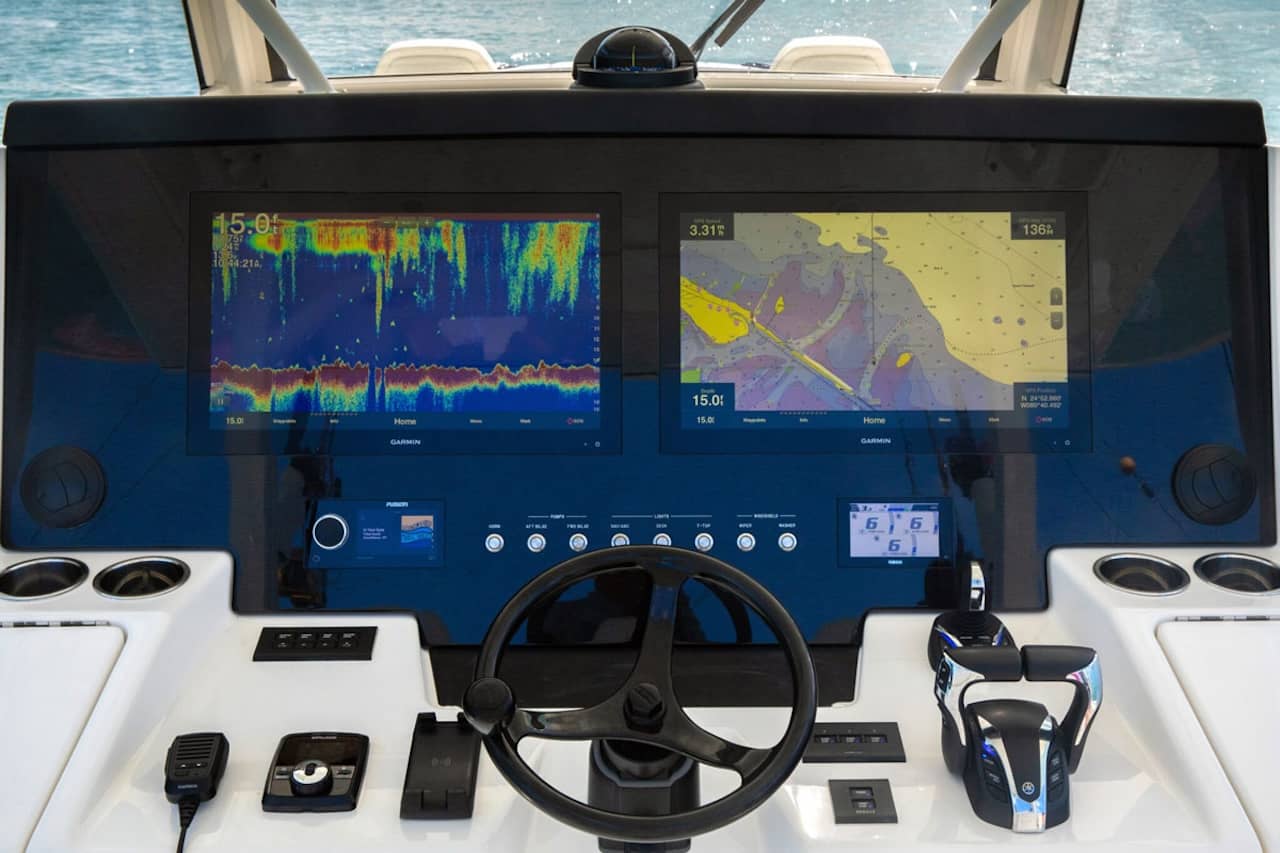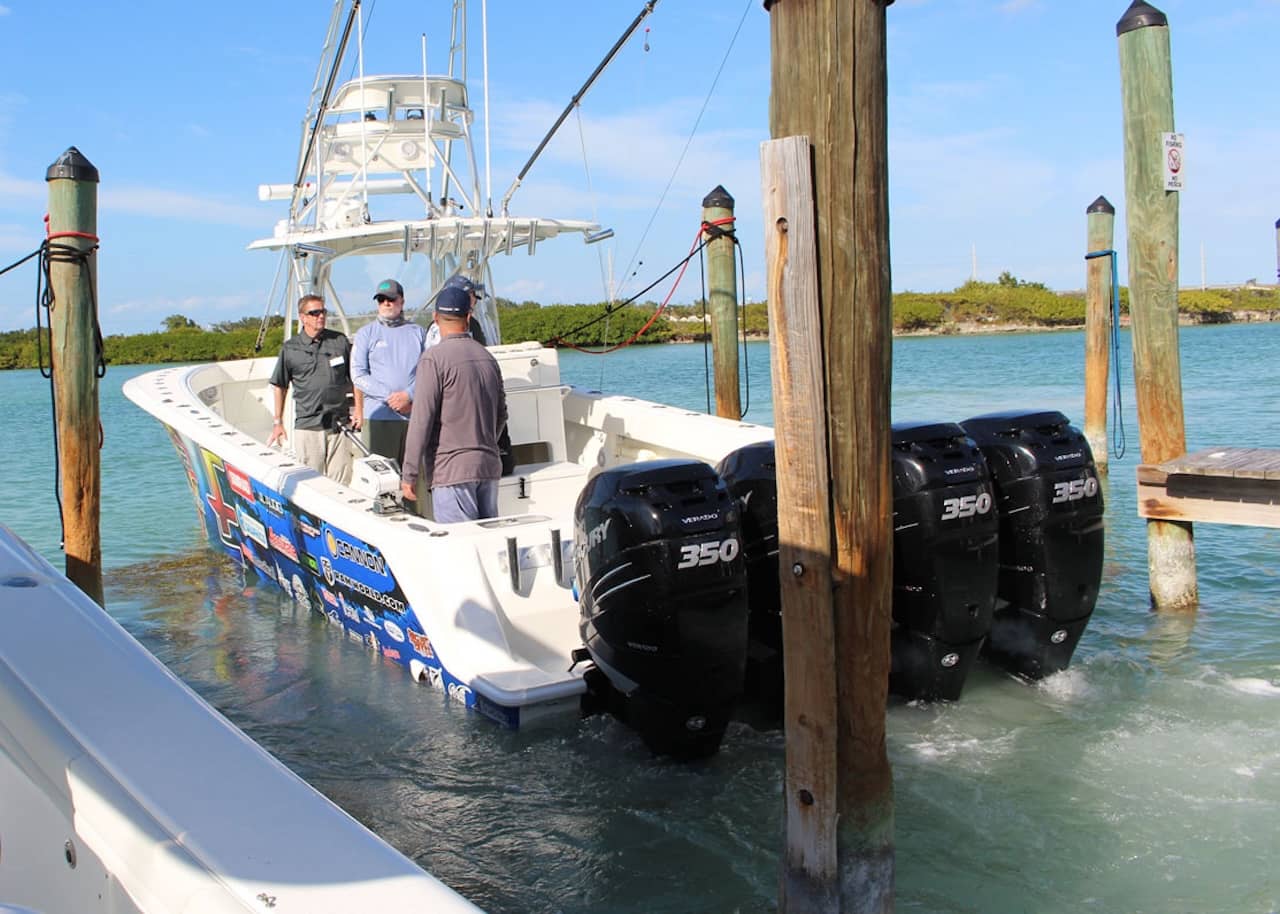Most new boaters report that docking a boat is the most stressful part of learning how to be the captain. What’s worse is that slightly different techniques may be necessary depending on how many engines your boat has and its type of control system. The good news is that whether your boat is a center console or a cabin cruiser, if it has two or more engines there’s a good chance you’ll be docking it with a joystick. Joystick controls have simplified all sorts of low-speed maneuvers and pulling into a slip or alongside the fuel dock is certainly one scenario where they come in handy.

Which will you reach for, the joystick or the throttles? If you’ve ever played a video game, we think we know the answer. Yamaha photo.
How to Dock a Boat
Anytime you’re docking a boat, be it with a joystick or via the throttles and a wheel, there are some rules and tips that apply across the board. Most of these relate to being properly prepared as you’re pulling up to the dock.
First off, get out lines and fenders well ahead of time and have them deployed where they’re needed. You don’t want there to be a mad scramble to grab things out of stowage compartments when the rubrail is getting ready to kiss up against a bulkhead. Cleat off the ends of the lines and get the fenders over the side.
Also, survey the environmental variables. These are the things that will likely determine just how difficult the docking experience will be at any given time on any given day. The two big ones that are likely to throw you a curveball are wind and current. Wind blowing away from the dock will hold you off of it, making collision less likely but also making it more difficult to park the boat where you want it. Wind blowing towards the dock will make it easy to approach but increases the chance you’ll come in too hot and make solid contact. So prior to pulling up close, look for a nearby flag or watch the treetops for a moment or two. Assess which way the wind is blowing and how much it’s likely to knock your boat out of kilter.
Current can have the same effect, grabbing your boat and pushing it unexpectedly one way or the other. Before you pull in close, try to find some way of gauging how strong the current is and which way it’s flowing. A buoy, crab, or lobster pot float, or a drifting boat will give you some indication, as will looking at the way the water is interacting with the pilings as you get up close to the dock. Tip: it’s always best to approach a dock with your bow into the current, whenever possible. Just as an airplane lands heading into the wind, you’ll have more steering control since water is rushing along your rudder or lower unit as opposed to pushing you from behind.
One final part of boat-docking preparation is getting your crew ready. A small boat can easily be docked single-handed, but on larger boats you may want to post someone on the bow, in the cockpit, or both. And be sure to advise them not to allow any part of their body to come between the boat and the dock when fending, or serious injury may occur.

With multiple-engine rigs, joysticks make docking a breeze. Lenny Rudow photo.
Using a Joystick to Dock a Boat
Docking with joystick controls is completely intuitive for anyone who’s ever played a video game with a joystick, and that’s just about everyone. Simply drive the boat close to the dock, then activate the joystick system and push the stick for directional control while twisting the top of the stick to spin the boat one way or the other. You can use a combination of the motions at the same time to nudge the bow or stern this way or that while moving the boat forward, aft, or sideways. Once the boat is positioned, push the joystick to one side or the other to “walk” it sideways to the dock, or pull it back to reverse the boat into a slip. Remember that you can apply more or less power by how hard you push and/or turn the joystick, because most systems will apply power proportionally.
Note that many joystick systems have different low- and high-power modes. Low is generally used in close quarters and limits engine RPM to a certain level so you don’t accidentally apply too much oomph when you’re in close proximity to things like pilings and docks. High power may be necessary in areas with strong tidal force where you’ll be battling a ripping current, and with some systems high power mode may actually be used to steer the boat at cruising speeds. Generally speaking, however, you should usually be in low-power docking mode when bringing your boat against the dock with a joystick.

Using a joystick, it’s possible to slide a boat sideways. Evinrude/BRP photo.
Docking with a Single Engine and Throttle
When using the wheel and throttle to dock a boat, you’ll generally begin your approach to the dock at an angle, with a 45-degree angle being about right but depending to some degree on the docking situation, the current, and the breeze. If the boat’s being pushed away from the dock you may want to approach from a shallower angle, so you can get as close as possible while still applying power and maintaining steerage. If the boat’s being pushed towards the dock, a wider angle can be helpful so you can turn parallel to the dock while still several feet away, knowing that the breeze or current will get you into your final position without applying any extra power (thus minimizing your speed of approach).
In the case of pulling into a slip, most of these factors remain more or less the same, except that you’ll want to swing the bow out away from the slip at the last moment, then shift into reverse to back in. If you end up askew, simply circle back around for another approach. Also remember that in the case of an outboard boat, the bow will be subject to swinging in the wind and in a very strong wind, it may be close to impossible to bring it around into position. In this case you may want to use a tactic known as “kissing” a piling. Bring the boat up perpendicular to the slip, moving forward until the stern is past one piling and the bow or amidships area is resting on the other. Then cut the wheel hard over and shift into reverse (judiciously) so the boat pivots around the piling and into the slip.
Docking with Twin Engines
Everything we’ve talked about for docking with a single engine holds true for twins, with one big difference: you can oppose twin engines (shift one into forward and the other into reverse) to spin the boat. Different boats react differently to this maneuver depending on several factors, especially how widely spaced the propellers are. In some cases the level of control will be dramatic, and in others you may need to apply a lot of power to get any sort of result. So before attempting to maneuver your boat by opposing the engines, pick a safe area of open water to experiment a bit, and get accustomed to how it will react.
One critical item to remember: whenever controlling a twin-engine boat by opposing the engines, center the steering wheel and leave it there. You can make adjustments to the boat’s position by giving one throttle or the other a bit more or less power, and if the thrust is directed off-center (in the case of outboards and stern drives), the boat may not react as you expected.
What about docking with more than two engines? Every rig is a bit different and you’ll need to learn how yours works. That said, if you have digital throttles in most cases the inside engine(s) will “drop out” and remain in neutral in docking mode. With mechanical controls simply use the outside throttles, only.
So, which is easier to dock a boat with, joysticks or throttles? You’ll still hear people argue that throttles are the way to go, but virtually without exception, the people making that argument are old-timers who grew up running boats with throttles. For the rest of us, those joystick boat controls are a hands-down winner around the docks.

With twin engines, you can oppose the powerplants to spin the boat. Lenny Rudow photo.
For more intel on how to captain your boat see How to Drive a Boat with Confidence.



